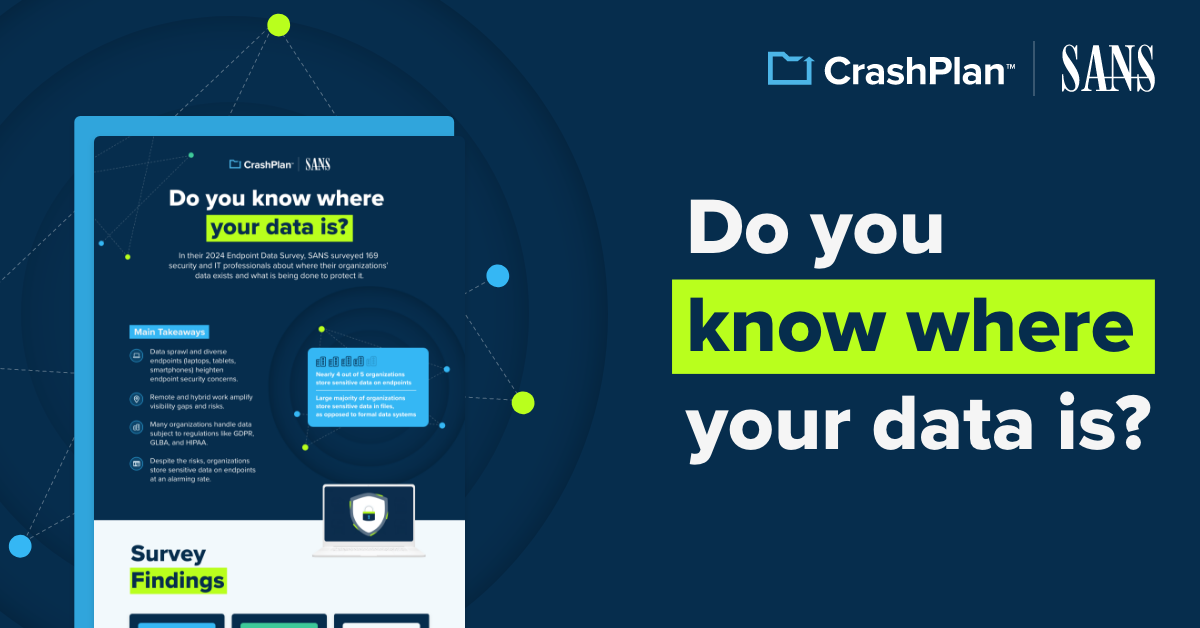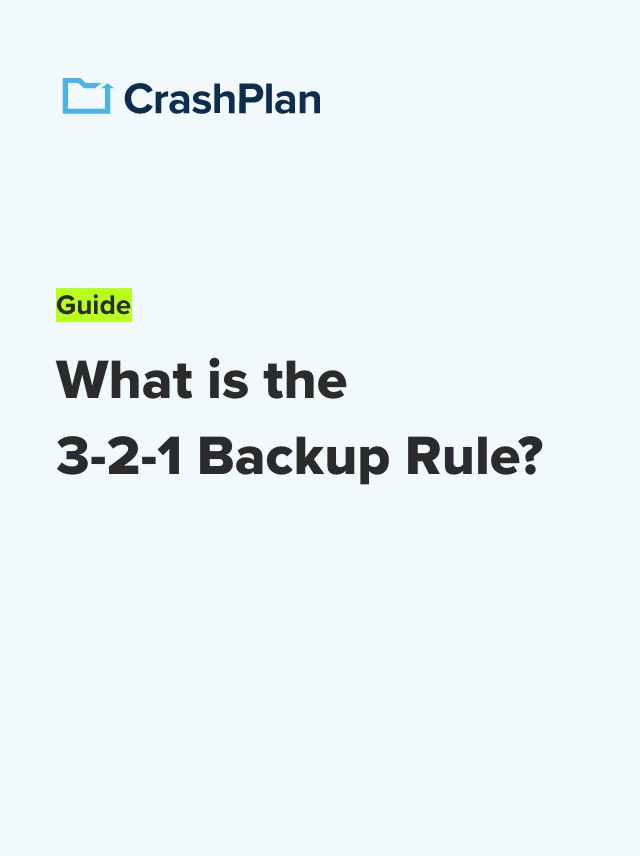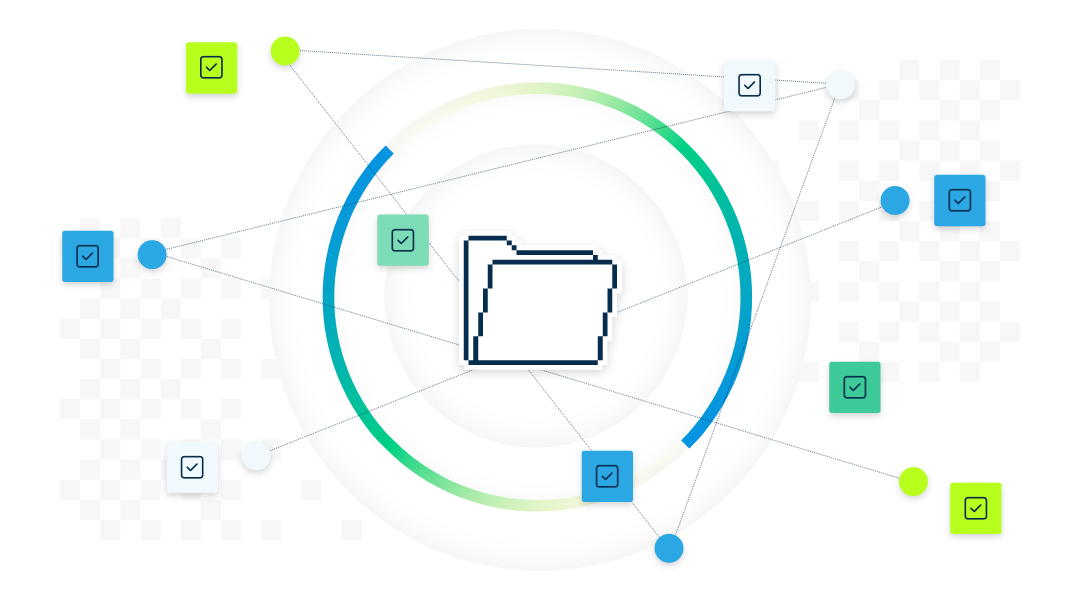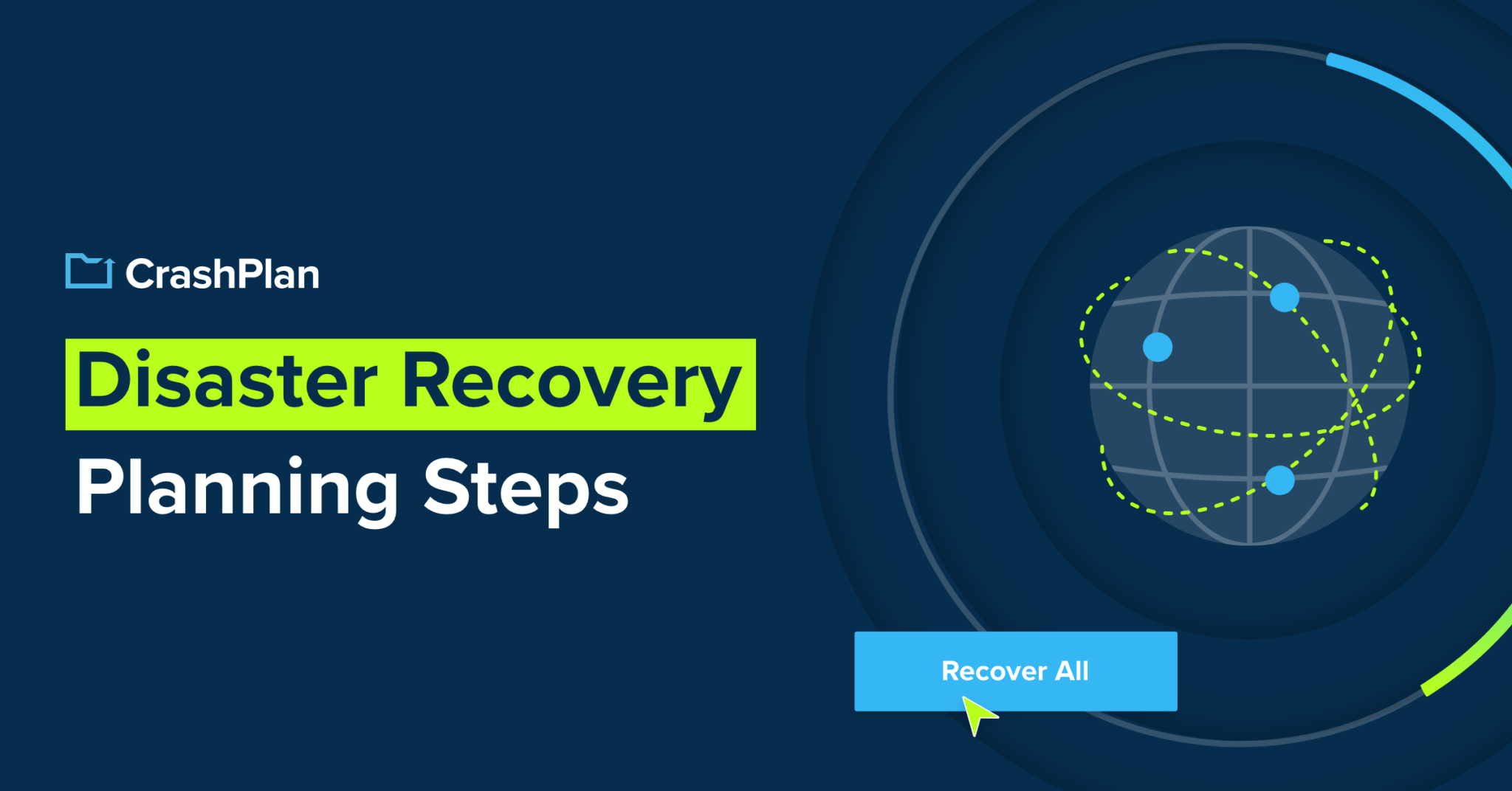As collaborative tools and cloud storage increase in popularity, you may wonder how data loss protection applies to your company, what the best data backup practices are, or whether you can trust cloud applications to properly store your precious information.
As backup applications continue to expand, CrashPlan is offering this extensive guide to help you navigate the often-murky waters of business data loss protection. We’ve tapped business leaders and IT pros to uncover the features and functionalities that offer you the best protection against losing your data.
Table of Contents
- What Is Data Loss Protection?
- What Is Not Data Loss Protection
- What Causes Business Data Loss?
- The Impact of Data Loss on Business
- Cloud Storage vs. Data Loss Protection: What’s the Difference?
- The Common Mistakes & Best Practices of Data Loss Protection
- Five Keys to Building a Data Loss Protection Strategy for Imperfect Humans
- Data Loss Protection Deal Breakers
- Crashplan Data Loss Protection
1. What is data loss protection?
Data loss protection is the processes, tools and preventive measures used to detect any potential data breaches in your company-wide stored information. By detecting and blocking sensitive data, monitoring outside intrusion and averting data leakages, data loss protection software can save your company from potentially devastating risks.
2. What Is Not Data Loss Protection?
It is important to remember that Data Loss Protection is separate and distinct from Data Loss Prevention. Data Loss Protection is focused on ensuring that when your business is struck by data loss (in whatever form it takes), you are protected from losing that data by having a copy of it stored off-site. Data Loss Prevention, however, is focused on stopping data from leaving your business through a highly complex, time consuming, resource intensive, and draconian process that tries — and usually fails — to block all the ways that data can leave. A common side-effect of most Data Loss Prevention tools is a large decrease in employee productivity because they are no longer able to work in the way that they are accustomed to.
3. What causes business data loss?
Data loss can be the result of a variety of mistakes and risks, such as data leakages, technological failures, theft, viruses, user error or even spilling a cup of coffee.
Top causes of business disruption
- Hardware failure: 140,000 hard drives fail every week.
- User error: Coffee spilled, simple employee mistakes—from errant clicks to lost laptops—accounted for 1 in 7 data breach incidents in 2016.3
- Natural disaster: Building fires, floods and other unexpected disasters have hit CrashPlan customers – and we helped them recover with limited downtime.
- Cybercrime: Small businesses are prime targets of cybercrime. Half of small businesses have already been hit with ransomware and 43% are prime targets for malware attacks.
4. The impact of data loss on business
Losing critical data like customer information, financial account information or intellectual property – or even temporarily losing access to that data – leads to devastating costs.
The devasting costs of losing data:
- Downtime: Losing data or files that are essential to your business can cause your business to completely shutdown.
- Lost productivity: Almost 80 percent of downtime costs come from lost employee productivity. Your employees can’t do their day-to-day work because they can’t access their files.
- Recreating lost work: If files can’t be recovered, you’re stuck with the cost – in time and labor- of recreating them.
- Missed sales opportunities: It’s a fast-paced, no-apologies world. If your sales team can’t give a presentation because the pitch deck is lost, that opportunity might be gone for good.
- Lost revenue: Downtime, lost productivity, missed sales opportunities—these all hit your bottom line, hard.
5. Cloud storage vs. data loss protection: What’s the difference?
Data loss in cloud computing is often an overlooked threat when it comes to data loss protection. The collaboration tools are a modern and innovative way to store your data, but here’s why you may need some added protection.
Cloud collaboration tools: powering modern productivity
Cloud collaboration tools like Google Drive, Microsoft OneDrive, Box and Dropbox drive powerful new ways of working—enabling seamless sharing of ideas and data that accelerates the speed of business, increases efficiency and enhances client and customer experiences.
Does Cloud Storage = data loss protection?
As businesses look for new ways to leverage cloud collaboration tools, it’s tempting to see them as a potential replacement for a true data loss protection product. But a tool that stores files in the cloud is not the same as automatic cloud data loss protection. In fact, these tools’ greatest strengths become dangerous weaknesses when used in place of true automatic cloud-based backup potentially, exposing your business to big risks—from helping spread malware or ransomware to losing productivity, revenue, and even customers.
To help businesses maximize the value of their cloud collaboration tools—while protecting their files, their intellectual property, and their productivity—CrashPlan has evaluated how the strengths of collaboration tools can also be their biggest weakness.
Cloud data loss protection + collaboration tools:
Better together
- Cloud collaboration tools
- Access files anywhere
- Easily choose files to share
- Sync the latest edits instantly
- Keep your business moving forward
Automatic cloud backup
- Secure files everywhere
- Automatically protect every file
- Restore any version immediately
- Always bounce back
The risks of relying on cloud collaboration as data loss protection
- A strength: Syncs the most recent versions of the files your employees are currently working on.
- Becomes a weakness: Employees only share files in the later stages of completion. Work-in-progress files, notes, ideas and all the other work that comes before a “shareable” draft are completely unprotected from data loss.
Completely dependent on employee compliance
- A strength: Gives users maximum control over file access and sharing.
- Becomes a weakness: Even if your official company policy is to save all files—including work-in-progress files—to the cloud sharing app, you’re still completely dependent on your employees remembering to manually save files, every time. If they forget—or ignore—that policy, valuable files are unprotected.
Limited storage
- A strength: “Free and unlimited” cloud storage.
- Becomes a weakness: If you use a cloud collaboration tool for truly comprehensive protection—every version of every file, for all time—you will likely hit the hidden limits of “unlimited” storage and end up paying a premium for added storage capacity.
Missing essential admin tools
- A strength: Functionality built with the end-user in mind.
- Becomes a weakness: Administrators don’t have any way to confirm which files are protected.
Not built to secure & protect valuable information
- A strength: Seamless access and easy sharing.
- Becomes a weakness: Cloud collaboration solutions are built for easy sharing—but that means they can easily share malware and viruses too. Data loss protection solutions provide an “air-gap” to help ensure infections aren’t shared.
Malware & ransomware spreads
- A strength: Real-time syncing and seamless file sharing.
- Becomes a weakness: Infected files that start on one employee’s device quickly spread to other users via automatic syncing. And worse, malware is specifically designed for this weakness, using cloud collaboration tools to penetrate all company files through a single device.
Plugging the gaps with automatic data loss protection
True data loss protection solutions offer unique functionality specifically designed to eliminate gaps and deliver comprehensive protection of all your files and data, so you can always bounce back—no matter what happens.
-
- Faster restores: Unique data storage techniques, simple restore workflows and point-in-time restore capabilities mean you can restore an entire laptop in minutes—with just a few clicks.Automatic: Protection happens silently and continuously–not vulnerable to employee mistakes, while not slowing work down, either.
- From the source: Automatic data loss protection pulls files directly from employees’ laptops and desktops, capturing all work-in-progress files to protect productivity.
- Comprehensive: True, automatic cloud data loss protection solutions cover every version of every file, so you can quickly go back to the moment before an incident occurred.
- Secure: Features like sophisticated encryption for data in transit and at rest and simple access controls protect your most valuable and sensitive information.
- Faster restores: Unique data storage techniques, simple restore workflows and point-in-time restore capabilities mean you can restore an entire laptop in minutes—with just a few clicks.
6. The common mistakes & best practices of data loss protection
With 37% of small and medium businesses losing data in the cloud, it’s no surprise data security experts and analysts agree: data loss protection is a critical complement to cloud-sharing apps. In many cases data loss prevention cannot be achieved, so businesses must practice data loss protection. In fact, the intellectual property (IP) contained in all those files make up around 80 percent of the typical business’ value. Dedicated data loss protection solutions plug the gaps left by cloud sharing apps, ensuring continuous data protection of all files. Data loss protection solutions are also purpose-built for the fastest disaster recovery, organizing files for quick restores and offering point-in-time restore. The bottom line: Cloud-sharing apps are designed to push work forward; data loss protection is purpose-built to allow you to bounce back.
Rather than building a backup strategy solely focused on hackers and cyberthreats, best practice is to take a holistic and honest approach that accounts for your employees’ natural (and human) tendencies. Seek out tools that empower them—not burden them. Build a data loss protection strategy that’s silent, automatic, constant and comprehensive— and keep your people (and your business) moving forward.
5 keys to building a better business data loss protection strategy for imperfect humans
I. Have a backup
The Common Mistake
Most companies think they have their files and data protected, but a recent study found that 58 percent of small businesses were not prepared for a data loss incident. Moreover, more than half of all backups (60%) ultimately fail to effectively restore the lost files, leaving the business starting from scratch.
Data Backup Best Practice
It’s worth saying out loud: Any protection is better than no protection. And make sure you’re following the basic “3-2-1” backup strategy:
II. Make it automatic: not human-dependent
The Common Mistake
Most companies think a lot about the backup itself: where it’s located, how it’s protected, etc. But what about how files and data get protected? Ironically, the traditional approach is to rely on employees to manually save important files to a server, a network drive or other designated locations. But if the biggest reason for protecting your files is to protect against human mistakes, you can’t have a policy that depends on those same mistake-prone humans. Think about this: Best practice is to protect all files every 15 minutes. If your employees really stopped to manually save files 32 times a day, you’d see a major drop in productivity.
Data Loss Protection Best Practice
All leading business data loss protection solutions now automatically and silently back up files continuously. You’re not vulnerable to employees forgetting to back up—and you aren’t burdening your employees with the constant, productivity-draining task of manually saving files.
III. Protect your files at the source: direct from the laptop or desktop
The Common Mistake
Research suggests 60 percent of your business’ files and data live exclusively on your employees’ desktops and laptops. If you’re only backing up a central destination like a network drive, all these work-in-progress files—all this productivity and value—are sitting on your employees’ laptops and desktops, not protected. That’s because employees typically only move files to the central destination when they’re finished—or at least in a “ready to share” state.
Data Loss Protection Best Practice
Since the majority of your business’ files and data now live on your employees’ desktops and laptops (where they do most of their work), leading data loss protection solutions is to protect files and data directly from these endpoint devices. This approach ensures business continuity, capturing and protecting all your employees’ productivity and value.
IV. Get the automatic data loss protection advantage: unlimited, more secure & most cost-effective
The Common Mistake
Another irony of traditional backup: Many companies still rely on hardware-based backup. Hardware has two big flaws: it fails, and it’s vulnerable to physical damage. Moreover, conventional, on-premises backup has all the shortcomings of conventional IT: A big capital investment upfront; a lengthy implementation period; and someone to manage and maintain its finite space.
Data Loss Protection Best Practice
The cloud’s multiple redundancies mean you’re never vulnerable to disaster or technology failure. Automatic data loss protection is simple—instantly up and running, with nothing to manage or maintain. Data security experts agree the cloud offers the most advanced security tools, thanks to real-time updates that include the latest security patches and new security features.
Finally, cloud storage provides a cost-effective option to protect all your files, so you don’t have to choose which files to protect. This means you can follow another data loss protection best practice: protect every version of every file, so you can instantly go back to the moment before an incident, restoring a “clean” version and minimizing lost productivity.
V. Cloud-sharing apps are NOT the same as automatic data loss protection
The Common Mistake
All cloud storage apps are not created equal. Cloud sharing apps like Dropbox, Google Drive, and Microsoft OneDrive are helping businesses of all sizes work in smart new ways. But, the same features that make cloud sharing apps great for sharing and collaboration make them a dangerous liability when used in place of real automatic cloud backup services:
- Depends on manual actions — Employees need to actively select files to add.
- Not all files are protected — Employees only share files in the later stages of completion. All the work that went into a “shareable” draft is vulnerable to total loss.
- One person’s mistakes become everyone’s — If one employee makes a mistake or deletes a file—and doesn’t catch it immediately—that mistake becomes everyone’s problem.
- Can spread malware and ransomware — If one employee shares an infected file, it can quickly spread to everyone.
- Not designed for easy, fast file restores — If several files—or an entire laptop—are lost, the disaster recovery process typically requires a time- consuming restore.
7. Data loss protection deal breakers
This quick list of deal breakers gives you 8 essential qualities to look for in a data loss protection solution. Consider it your cheat sheet for data loss protection “speed dating”: what to look for—and what to watch out for.
Deal breaker #1
Does it protect files off-site?
Data protection and security experts now agree the cloud is the best option for secure data storage. Unlike hardware-based storage (hard drives, external drives, on-premises servers), automatic data loss protection features multiple redundancies so you’re never vulnerable to a disaster or technology failure. Automatic cloud backup also offers the most advanced security tools, thanks to real-time updates that include the latest security patches and new security features.
Happily-ever-after outcome: True disaster protection and the very latest security features.
Deal breaker #2
Is it automatic?
Instead of relying on your employees to manually save files to a central location for protection (network drive, server, etc.), leading data loss protection solutions now automatically, silently and continuously protect files. You’re not vulnerable to employees forgetting to backup—and you aren’t burdening your employees with the constant, productivity-draining task of manual backup. Automatic data loss protection takes the onus off your employees and makes it easy to protect your business data.
Happily-ever-after outcome: Employees work uninterrupted and with the peace of mind of constant protection.
Deal breaker #3
Does it protect from the source (laptop/desktop) – no matter where employees are located?
About 60 percent of your business’ files and data live exclusively on your employees’ desktops and laptops. “Automatic” business data loss protection needs to pull files directly from these endpoint devices, capturing all their daily productivity and work-in-progress files— not just the “finished product” that gets saved and shared on the server. Automatic data loss protection services go a step further, pulling files directly from laptops, anytime, anywhere. This means you can free your employees to work remotely, knowing their work is always protected.
Deal breaker #4
Can it protect both Windows and Mac devices?
Macs continue to infiltrate the business world, and more companies are letting employees choose their own devices. But most backup products were built specifically for Windows—forcing you to either juggle two products, or risk files falling through the gaps if you use a Windows product to cover your Mac devices. “Platform-agnostic” data loss protection solutions solve this problem, giving you complete coverage for Mac and Windows from a single, simple product.
Happily-ever-after outcome: Protect every computer from one platform.
Deal breaker #5
Can you protect ALL your files?
Traditional backup solutions were limited (there’s only so much room in a physical hard drive or on-premises server), so you had to spend time carefully choosing which valuable files were worthy of protecting. But files can become incredibly important at unexpected times—even years down the road. Picking just one version of a file leaves too much room for error. Today, the efficiencies of cloud storage make unlimited data loss protection a cost-effective reality for businesses of all sizes. You don’t have to spend time classifying files and data—and you don’t have to worry that files are getting left out or are no longer available.
Happily-ever-after outcome: Worry-free protection of every file.
Deal breaker #6
Do the security features meet your compliance requirements?
Protecting your files is a critical piece in meeting compliance requirements—whether it’s PCI, HIPAA, GDPR, GLBA, SEC or another standard. Leading data loss protection solutions offer security features tailored to meet these compliance requirements, including advanced encryption for data in transit and in storage, robust access control, and the ability to keep files protected for the required period of time.
Happily-ever-after outcome: Worry-free data security compliance.
Deal breaker #7
Is it easy to deploy and maintain?
The “IT Team” in most small businesses is one person, juggling all IT plus their “day job” responsibilities. They can’t afford to spend hours every week managing a backup product. Best-in-class data loss protection solutions leverage the advantages of the cloud to deliver low-maintenance protection: Initial deployment takes an hour instead of days—and adding new users takes just a few clicks. Dashboards make it easy to see your files are protected. Simplified restore work flows even allow employees to do self-service restores. And because the solution lives in the cloud, all the technology maintenance is handled by your provider.
Happily-ever-after outcome: Less time worrying about your files; more time for your job!
Deal breaker #8
Is it built for the fastest recovery?
All the other fancy data loss protection features are worthless if you can’t restore files quickly when you need them—and time is often critical in file-loss situations. Leading data loss protection solutions are purpose-built using sophisticated data storage to restore files up to nine times faster. Intuitive folder structure and search capabilities make it easy to find the file(s) you need? Point-in-time restores let you roll an entire laptop (or all an employee’s files) back to the moment before an incident occurred.
Happily-ever-after outcome: You and your employees get back to business—sooner.
8. Keep your business moving forward with crashplan data loss protection
At its core CrashPlan protects you by making sure there is always another copy of your data, no matter what happens to your computer. You may be thinking “wait, that’s backup!”
CrashPlan closes the gaps left by old-school backup solutions, reduces your risk of losing critical business data, and makes it easy for you to keep serving your customers rather than fret about IT and Security. It does this in a number of ways.
- Free unlimited storage for one month
- Protect and manage as many devices as needed
- Easily recover and restore your data from a ransomware attack
CrashPlan is a cost-effective and simple way for any business to protect themselves from data loss. Your company can reduce the total amount of work you can lose in the event of a digital disaster from 24 hours down to just 30 minutes. If you’d like to try it out for yourself, sign up for our free trial!
- Faster restores: Unique data storage techniques, simple restore workflows and point-in-time restore capabilities mean you can restore an entire laptop in minutes—with just a few clicks.Automatic: Protection happens silently and continuously–not vulnerable to employee mistakes, while not slowing work down, either.
Ready for automatic backup to keep your files safe and secure?
Start your free trial of CrashPlan – no hidden costs or commitments.
Delivering peace of mind with unlimited automatic backup that is simple to use.





